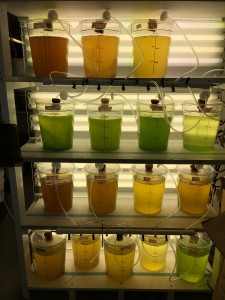We research global coastal change within three major realms:
Harmful algal blooms:
Our group is interested in understanding the functioning of  aquatic ecosystems and how that functioning can be affected by man or can affect man. We focus much of our effort investigating the organisms at the base of aquatic food webs, phytoplankton, and have been particularly focused on harmful algae. We investigate harmful algal blooms (HABs) caused by multiple classes of phytoplankton (cyanophyceae, dinophyceae, bacillariophyceae, pelagophyceae, ulvophyceae) in diverse ecosystems (e.g. estuaries, lakes, coastal ocean) using multiple approaches (field studies, laboratory experimental, field experiments, molecular investigations, modeling). Collectively, these studies have identified how nutrients, CO2 levels, zooplankton grazing, viral lysis, allelopathy and grazing by bivalves influence the dynamics of HABs caused by genera such as Alexandrium, Anabaena/Dolichospermum, Aureococcus, Aureoumbra, Cochlodinium/Margalefidinium, Dinophysis, Microcystis, Pseuodonitzschia, and Ulva.
aquatic ecosystems and how that functioning can be affected by man or can affect man. We focus much of our effort investigating the organisms at the base of aquatic food webs, phytoplankton, and have been particularly focused on harmful algae. We investigate harmful algal blooms (HABs) caused by multiple classes of phytoplankton (cyanophyceae, dinophyceae, bacillariophyceae, pelagophyceae, ulvophyceae) in diverse ecosystems (e.g. estuaries, lakes, coastal ocean) using multiple approaches (field studies, laboratory experimental, field experiments, molecular investigations, modeling). Collectively, these studies have identified how nutrients, CO2 levels, zooplankton grazing, viral lysis, allelopathy and grazing by bivalves influence the dynamics of HABs caused by genera such as Alexandrium, Anabaena/Dolichospermum, Aureococcus, Aureoumbra, Cochlodinium/Margalefidinium, Dinophysis, Microcystis, Pseuodonitzschia, and Ulva.
Interactions between climate change and eutrophication:
The second major research focus within our laboratory is understanding how  climate change and coastal ocean acidification affects marine organisms and ecosystems. The combustion of fossil fuels has enriched levels of CO2 in the world’s oceans and decreased ocean pH. The degradation of anthropogenically-enriched organic matter in coastal ecosystems seasonally has a similar effect on ocean chemistry today, while concurrently depressing dissolved oxygen levels. The continuation of these processes can alter the growth, survival, and diversity of marine organisms. Within this realm, we have been measuring and monitoring the occurrence of hypoxia, acidification, and warming trends in dozens of coastal systems for nearly two decades in many cases using approached that provide high resolution, temporal, vertical, and horizontal records. We are also engaged in studies investigating how future and current coastal ocean acidification affects the survival and performance of algae and larvae from bivalves and fish indigenous to North America. We further strive to understand how co-occurring stressors related to both climate change and shallow coastal ecosystems (hypoxia, thermal stress, algal blooms) may act and interact to affect the performance of marine animals.
climate change and coastal ocean acidification affects marine organisms and ecosystems. The combustion of fossil fuels has enriched levels of CO2 in the world’s oceans and decreased ocean pH. The degradation of anthropogenically-enriched organic matter in coastal ecosystems seasonally has a similar effect on ocean chemistry today, while concurrently depressing dissolved oxygen levels. The continuation of these processes can alter the growth, survival, and diversity of marine organisms. Within this realm, we have been measuring and monitoring the occurrence of hypoxia, acidification, and warming trends in dozens of coastal systems for nearly two decades in many cases using approached that provide high resolution, temporal, vertical, and horizontal records. We are also engaged in studies investigating how future and current coastal ocean acidification affects the survival and performance of algae and larvae from bivalves and fish indigenous to North America. We further strive to understand how co-occurring stressors related to both climate change and shallow coastal ecosystems (hypoxia, thermal stress, algal blooms) may act and interact to affect the performance of marine animals.
Phase shifts in coastal ecosystems:
A third area of interest of our lab group is the understanding the  ecological functioning and trophic status of shallow marine ecosystems. We investigate how anthropogenic activities such as eutrophication and the depletion of fisheries may alter the natural ecological and/or biogeochemical functioning of coastal ecosystems. In many cases, we have explored the quantitative importance and impacts of various nitrogen loading pathways on primary producers or the interactions and feedbacks among nutrient delivery pathways, pelagic phytoplankton communities, benthic filter feeders, and benthic autotrophs such as seagrass and seaweeds. All of these studies have important societal impacts and relevance for the management of shallow, coastal ecosystems.
ecological functioning and trophic status of shallow marine ecosystems. We investigate how anthropogenic activities such as eutrophication and the depletion of fisheries may alter the natural ecological and/or biogeochemical functioning of coastal ecosystems. In many cases, we have explored the quantitative importance and impacts of various nitrogen loading pathways on primary producers or the interactions and feedbacks among nutrient delivery pathways, pelagic phytoplankton communities, benthic filter feeders, and benthic autotrophs such as seagrass and seaweeds. All of these studies have important societal impacts and relevance for the management of shallow, coastal ecosystems.